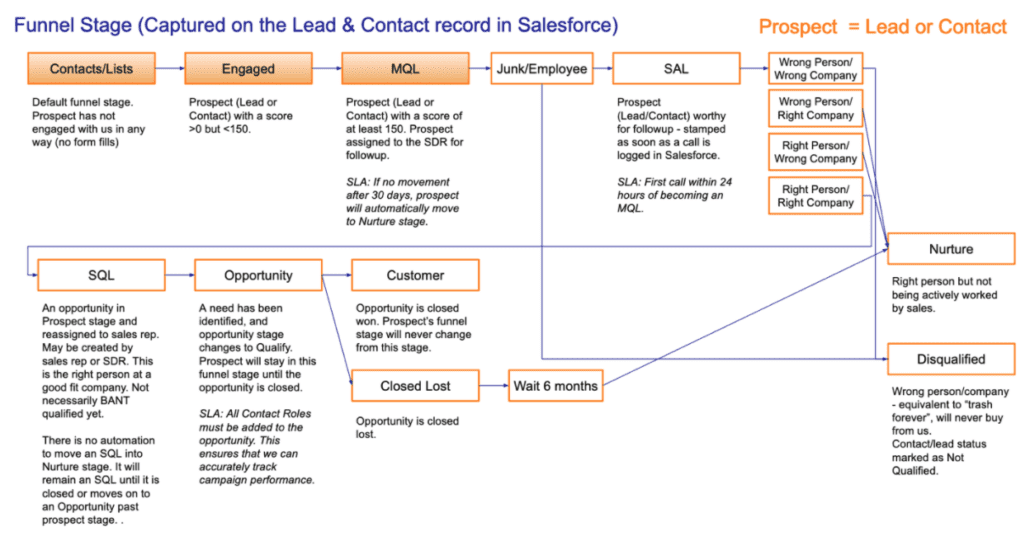How are things actually working? Where do our leads fall out? Is our process optimal? We all want to improve conversions and increase revenue, but it can be tough to understand if your people, tools, or process actually translate into measurable revenue. Here are 8 ways we’ve seen clients document (and optimize) their lead management process.
>> Related: It’s Time to Abandon TQL and SAL in Your Lead Funnel <<
In this post:
Lead Management Process Samples
Hybrid ABM
I would say most of our clients fall into this category, in which marketing campaigns do target specific accounts, but viable leads come in across different channels from non-target accounts.
In a hybrid model, it’s most common to see a combination of BDRs and AEs, where BDRs are responsible for qualifying non-target accounts and lower quality MQLs from target accounts. Meanwhile AEs focus on handraiser leads from target accounts.
Click the images to expand
Here’s another visualization from another client to show the dispositions for qualifying leads out of the sales funnel.
ABM with BDRs/AEs
Here’s an example where target account leads are assigned directly to Sales. If the lead doesn’t match a target account, the BDR jumps in to do additional research before passing the lead up to Sales.
This process works best if your target universe is quite narrow and/or you have a high AE:BDR ratio.
>> Related: Rethinking the ABM Sales Funnel <<
ABM with AEs only
In this simple process, leads that don’t match target accounts DO NOT qualify as MQLs. Since there are no BDRs, Sales doesn’t have time to weed through non-target accounts, so the MQL threshold is usually quite high. From there, the AE is immediately looking to schedule a meeting. If qualified, the AE creates an opportunity right away.
VIP Leads
Here’s an example where hot/warm leads are assigned directly to Sales. If the lead is cold, the BDR jumps in to do additional research before passing the lead up to Sales.
This process also has extensive fallbacks to ensure if AEs can’t get to the call in time, a BDR will jump in.
This process work especially well if it’s critical that the first touch is a high-quality conversation and/or you have a high AE:BDR ratio
Person Accounts
We most often see Person Accounts in healthcare and financial services. This example is from a health tech client – an app for diabetes patients. All of the screening and enrollment process lives in Salesforce, and the dietitians/customer success teams use opportunity stages to manage the pipeline from New>Qualified Diagnosis>A1C Validation>Enrolled.
Lead Conversions
Finally, here’s an example from a B2C client that provides self-service analytics software. There is no human required here at all, but obviously tracking a prospect’s progress through the funnel is critical so we can answer questions, troubleshoot technical issues, etc. to help them move forward.

Document your own Lead Management Process
My favorite way to understand a funnel’s strengths and weaknesses is to follow leads through their entire journey, all the way from their first impression to a closed won opportunity.
This is all about the nitty gritty. Interview or shadow actual reps, and screen share to see their lead queues and workflows:
- How do reps get notified of new leads?
- Can reps cold prospect into the marketing database?
- What is the goal of BDRs?
- How do BDRs notify Sales of opportunities?
- How do “marketing sourced” opportunities get created?
- Does Sales receive MQLs? How do they get notified?
- What are the biggest gaps / hiccups in the process? Where do most leads fall out?
- How do you recycle leads? Do you DQ leads?
- How are MQLs created? How do people know it’s an MQL?
Quick[er] projects to get started
If you’re realizing your lead-to-revenue process is ghosting leads, I recommend starting with one of these projects:
- Reshape Sales’ & Marketing’s roles and responsibilities, for example, having BDRs create Opportunities
- Create new ICP fit, BANT criteria, MQL threshold, etc.
- Implement simple, self-evident lead stages
- Negotiate the Marketing-to-Sales handoff, including SLAs for follow up
Change is hard, and it takes most of our clients over a year to completely transform their lead management process. Prioritize one of these projects as a pilot, get an early win, and build your momentum. And, of course, if you want Sponge.io to help, just get in touch!











